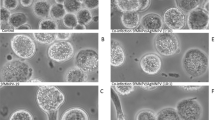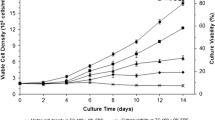Abstract
The UFL-AG-286 cell line, established from embryonic tissue of the lepidopteran insect Anticarsia gemmatalis, has been identified as a good candidate to be used as a cellular substrate in the development of a process for in vitro production of the Anticarsia gemmatalis multicapsid nucleopolyhedrovirus, a baculovirus widely used as bioinsecticide. In order to characterize the technological properties of this cell line and evaluate its feasibility to use it for the large-scale production of Anticarsia gemmatalis multicapsid nucleopolyhedrovirus, UFL-AG-286 cells were adapted to grow as agitated suspension cultures in spinner-flasks. Batch suspension cultures of adapted cells in serum-supplemented TC-100 medium grew with a doubling time of about 29 h and reached a maximum cell density higher than 3.5 × 106 viable cells ml−1. At the end of the growth period glucose was completely depleted from the culture medium, but l-lactate was not produced. Amino acids, with the exception of glutamine, were only negligibly consumed or produced. In contrast to other insect cell lines, UFL-AG-286 cells appeared to be unable to synthesize alanine as a metabolic way to dispose the by-product ammonia. The synchronous infection of suspension cultures with Anticarsia gemmatalis multicapsid nucleopolyhedrovirus in the early to medium exponential growth phase yielded high amounts of both viral progenies per cell and reduced the specific demands of UFL-AG-286 cells for the main nutrients.





Similar content being viewed by others
Abbreviations
- AgMNPV:
-
Anticarsia gemmatalis multicapsid nucleopolyhedrovirus
- NOV:
-
non-occluded virus
- PIB:
-
polyhedral inclusion body
- TCID50% :
-
tissue culture infectious dose 50%
References
Batista FRX, Pereira CA, Mendonça RZ, Moraes AM (2005) Enhancement of Sf9 cells and baculovirus production employing Graces’s medium supplemented with milk whey ultrafiltrate. Cytotechnology 49:1–9
Bédard C, Kamen AA, Tom R, Massie B (1994) Maximization of recombinant protein yield in the insect cell/baculovirus system by one-time addition of nutrients to high-density batch cultures. Cytotechnology 15:129–138
Bédard C, Perret S, Kamen AA (1997) Fed-batch culture of Sf-9 cells supports 3 × 107 cells per ml and improves baculovirus-expressed recombinant protein yields. Biotechnol Lett 19:629–632
Bédard C, Tom R, Kamen AA (1993) Growth, nutrient consumption, and end-product accumulation in Sf-9 and BTI-EAA insect cell cultures: insights into growth limitation and metabolism. Biotechnol Prog 9:615–624
Benslimane C, Elias CB, Hawari H, Kamen A (2005) Insights into the central metabolism of Spodoptera frugiperda (Sf-9) and Trichoplusia ni BTI-Tn-5B1-4 (Tn-5) insect cells by radiolabeling studies. Biotechnol Prog 21:78–86
Castro MEB, Souza ML, Araujo S, Bilimoria SL (1997) Replication of Anticarsia gemmatalis nuclear polyhedrosis virus in four lepidopteran cell lines. J Invertebr Pathol 69:40–45
Chakraborty S, Monsour C, Teakle R, Reid S (1999) Yield, biological activity, and field performance of a wild-type Helicoverpa nucleopolyhedrovirus produced in H. zea cell cultures. J Invertebr Pathol 73:199–205
Claus JD, Remondetto GE, Guerrero SA, Demonte AM, Murguía M, Marcipar AJ (1993) Anticarsia gemmatalis nuclear polyhedrosis virus replication in serum-free and serum-reduced insect cell cultures. J Biotechnol 31:1–15
Dee KU, Shuler ML, Wood HW (1997) Inducing single-cell suspension cultures of BTI-TN5B1-4 insect cells: 1. The use of sulfated polyanions to prevent cell aggregation and enhance recombinant protein production. Biotechnol Bioeng 54:191–205
Donaldson MS, Shuler ML (1998) Effects of long-term passaging of BTI-Tn5B1-4 insect cells on growth and recombinant protein production. Biotechnol Prog 14:543–548
Doverskog M, Han L, Häggström L (1998) Cystine/cysteine metabolism in cultured Sf9 cells: influence of cell physiology on biosynthesis, amino acid uptake and growth. Cytotechnology 26:91–102
Doverskog M, Ljunggren J, Öhman L, Häggström L (1997) Physiology of cultured animal cells. J Biotechnol 59:103–115
Drews M, Doverskog M, Öhman L, Chapman BE, Jacobsson U, Kuchel PW, Häggström L (2000) Pathways of glutamine metabolism in Spodoptera frugiperda (Sf9) insect cells: evidence for the presence of the nitrogen assimilation system, and a metabolic switch by 1H/15N NMR. J Biotechnol 78:23–37
Drews M, Paalme T, Vilu R (1995) The growth and nutrient utilization of the insect cell line Spodoptera frugiperda Sf9 in batch and continuous culture. J Biotechnol 40:187–198
Elias CB, Zeiser A, Bédard C, Kamen AA (2000) Enhanced growth of Sf-9 cells to a maximum density of 5.2 × 107 cells per ml and production of β-galactosidase at high cell density by fed-batch culture. Biotechnol Bioeng 68:381–388
Férrance JP, Goel A, Ataai AM (1993) Utilization of glucose and amino acids in insect cell cultures: quantifying the metabolic flows within the primary pathways and medium development. Biotechnol Bioeng 42:697–707
Grasela JJ, McIntosh AH (1998) In vitro and in vivo host range of Anticarsia gemmatalis multiple nuclear polyhedrosis virus. In Vitro Cell Dev Biol – Animal 34:79–83
Ikonomou L, Schneider Y-J, Agathos SN (2003) Insect cell culture for industrial production of recombinant proteins. Appl Microbiol Biotechnol 62:1–20
Kamen AA, Bédard C, Tom R, Perret S, Jardin B (1996) On-line monitoring of respiration in recombinant-baculovirus-infected and uninfected insect cell bioreactor cultures. Biotechnol Bioeng 50:36–48
Lynn DE (2003) Comparative susceptibilities of twelve insect cell lines to infection by three baculoviruses. J Invertebr Pathol 82:129–131
McKenna KA, Shuler ML, Granados RR (1997) Increased virus production in suspension culture by a Trichoplusia ni cell line in serum-free media. Biotechnol Prog 13:805–809
Mendonça RZ, Palomares LA, Ramírez OT (1999) An insight into insect cell metabolism through selective nutrient manipulation. J Biotechnol 72:61–75
Meneses-Acosta A, Mendonça RZ, Merchant H, Covarrubias L, Ramírez OT (2001) Comparative characterization of cell death between Sf9 insect cells and hybridoma cultures Biotechnol Bioeng. 72:441–457
Moscardi F (1999) Assessment of the application of baculoviruses for control of Lepidoptera. Annu Rev Entomol 44:257–289
Moscardi F (1993) Soybean integrated pest management in Brazil. Plant Protect Bull 41:91–100
Moscardi F, Allen GE, Greene GL (1981) Control of the velvetbean caterpillar by nuclear polyhedrosis virus and insecticides and impact of treatments on the natural incidence of the entomopathogenic fungus Nomuraea rileyi. J Econ Entomol 74:480–485
Murhammer DW (1996) Use of viral insecticides for pest control and production in cell culture. Appl Biochem Biotechnol 59:199–220
Neermann J, Wagner R (1996) Comparative analysis of glucose and glutamine metabolism in transformed mammalian cell lines, insect and primary liver cells. J Cell Physiol 166:152–169
Nguyen B, Jarnagin S, Williams S, Chan H, Barnett J (1993) Fed-batch culture of insect cells: a method to increase the yield of recombinant human nerve growth factor (rhNGF) in the baculovirus expression system. J Biotechnol 31:205–217
Öhman L, Alarcón M, Ljunggren J, Ramqvist AK, Häggström L (1996) Glutamine is not an essential amino acid for Sf-9 insect cells. Biotechnol Lett 18:765–770
Palomares LA, López S, Ramírez OT (2004) Utilization of oxygen uptake rate to assess the role of glucose and glutamine in the metabolism of infected insect cell cultures. Biochem Eng J 19:87–93
Palomares LA, Ramírez OT (1996) The effect of dissolved oxygen tension and the utility of oxygen uptake rate in insect cell culture. Cytotechnology 22:225–237
Pasumarthy MK, Murhammer DW (1994) Clonal variation in the Spodoptera frugiperda IPLB-SF-21 AE insect cell population. Biotechnol Prog 10:314–319
Radford KM, Reid S, Greenfield PF (1997) Substrate limitation in the baculovirus expression vector system. Biotechnol Bioeng 56:32–44
Reed L, Muench H (1938) A simple method for estimating fifty percent endpoints. Am J Hyg 27:493–497
Rhiel M, Mitchell-Logean CN, Murhammer DW (1997) Comparison of Trichoplusia ni BTI-Tn5B1-4 (High Five) and Spodoptera frugiperda Sf-9 insect cell line metabolism in suspension cultures. Biotechnol Bioeng 55:909–920
Rhiel M, Murhammer D (1995) The effect of oscillating dissolved oxygen concentrations on the metabolism of a Spodoptera frugiperda IPLB-Sf-21 AE clonal isolate. Biotechnol Bioeng 47:640–650
Rodas VM, Marques FH, Honda MT, Soares DM, Jorge SAC, Antoniazzi MM, Medugno C, Castro MEB, Ribeiro BM, Souza ML, Tonso A, Pereira CA (2005) Cell culture derived AgMNPV bioinsecticide: biological constraints and bioprocess issues. Cytotechnology 48:27–39
Ryll T, Lucki-Lange M, Jäger V, Wagner R (1990) Production of recombinant interleukin 2 with BHK cells in a hollow fiber and a stirred tank reactor with protein-free medium. J Biotechnol 14:377–392
Schmid G (1996) Insect cell cultivation: growth and kinetics. Cytotechnology 20:43–56
Sieburth PJ, Maruniak JE (1988a) Growth characteristics of a continuous cell line from the velvetbean caterpillar, Anticarsia gemmatalis Hübner (Lepidoptera: Noctuidae) In vitro Cell. Dev Biol 24:195–198
Sieburth PJ, Maruniak JE (1988b) Susceptibility of an established cell line of Anticarsia gemmatalis (Lepidoptera: Noctuidae) to three nuclear polyhedrosis viruses. J Invertebr Pathol 52:453–458
Stavroulakis DA, Kalogerakis N, Behie LA, Iatrou K (1991) Kinetic data for the BM-5 insect cell line in repeated-batch suspension cultures. Biotechnol Bioengn 38:116–126
Sugiura T, Amann E (1996) Properties of two insect cell lines useful for the baculovirus expression system in serum-free culture. Biotechnol Bioeng 51:494–499
Wickham TJ, Nemerow GR (1993) Optimization of growth methods and recombinant protein production in BTI-Tn5B1-4 insect cells using the baculovirus expression system. Biotechnol Prog 9:25–30
Wong TKK, Nielsen LK, Greenfield PF, Reid S (1994) Relationship between oxygen uptake rate and time of infection of Sf-9 insect cells infected with a recombinant baculovirus. Cytotechnology 15:157–167
Zhang YH, Enden G, Merchuk JC (2005) Insect cells–Baculovirus system: factors affecting growth and low MOI infection. Biochem Eng J 27:8–16
Acknowledgements
The authors gratefully acknowledge support from ANPCyT (PICT 08-04411 BID 802 OC/AR) and Universidad Nacional del Litoral (CAI + D 2002).
Author information
Authors and Affiliations
Corresponding author
Rights and permissions
About this article
Cite this article
Gioria, V.V., Jäger, V. & Claus, J.D. Growth, metabolism and baculovirus production in suspension cultures of an Anticarsia gemmatalis cell line. Cytotechnology 52, 113–124 (2006). https://doi.org/10.1007/s10616-006-9042-3
Received:
Accepted:
Published:
Issue Date:
DOI: https://doi.org/10.1007/s10616-006-9042-3




